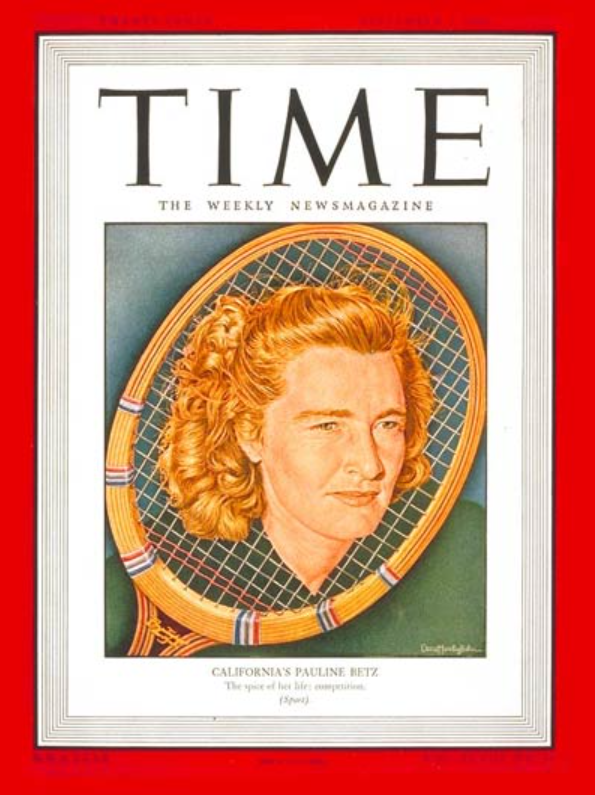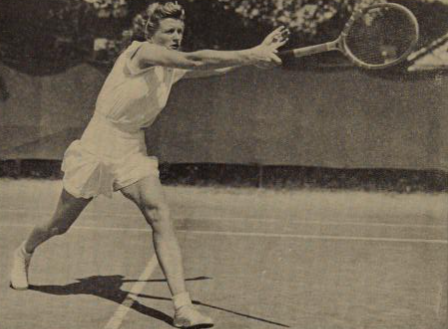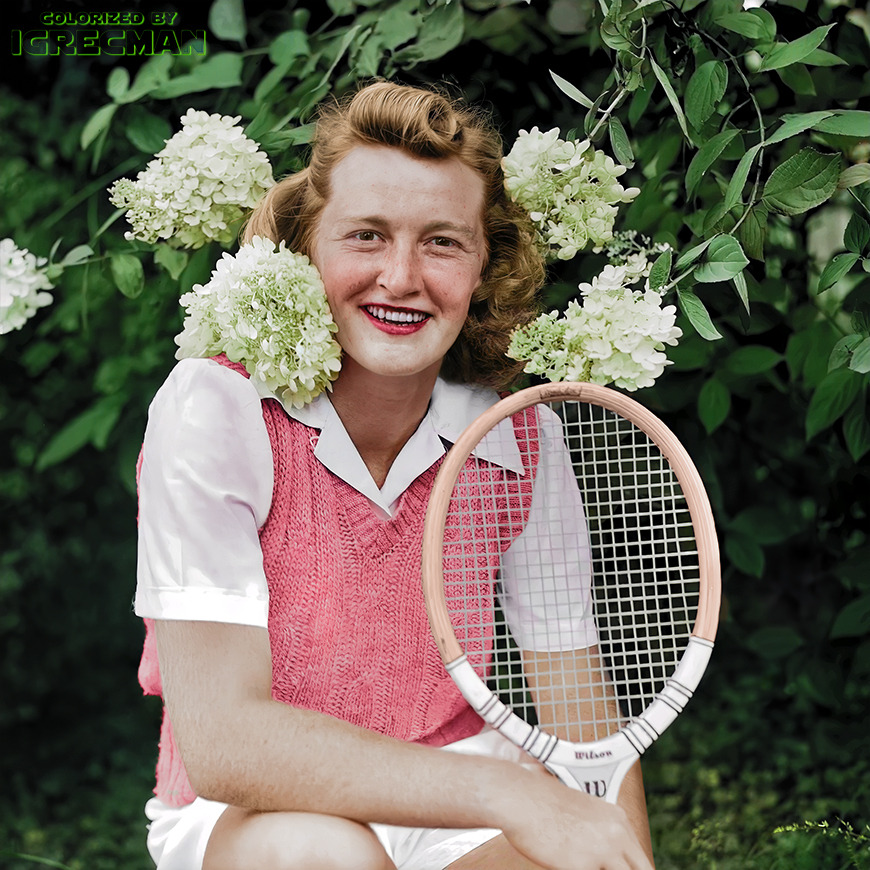
Colorization credit: Women’s Tennis Colorizations
In 2022, I’m counting down the 128 best players of the last century. With luck, we’ll get to #1 in December. Enjoy!
* * *
Pauline Betz [USA]Born: 6 August 1919
Died: 31 May 2011
Career: 1938-51
Played: Right-handed (one-handed backhand)
Peak rank: 1 (1946)
Peak Elo rating: 2,226 (1st place, 1947)
Major singles titles: 5
Total singles titles: 70
* * *
United States tennis emerged from World War II in remarkably good shape. The best men players, a strong contingent led by the big serve-and-volleyer Jack Kramer, were generally able to maintain their competitive form in the military. Some leading women lost practice time to wartime jobs, but their tournament schedule was largely unaffected by the conflict.
At the head of the women’s game was Pauline Betz. She didn’t have some of the world-class weapons of her primary rivals, like the kick serve of Louise Brough or Doris Hart’s cannonball. She made up for it with mental strength; if you were paying attention, you could watch as she set aside her own emotional reactions to the inevitable bad breaks. The tenacious Californian possessed a strong all-around game, and the contrast between Pauline and her bigger-hitting peers kept things interesting.
Betz was immensely likeable, both on court and off. She was a jokester on friendly terms with her fellow players, the so-called “Betz Club” of Brough, Hart, and Margaret Osborne. She hadn’t been particularly favored by Perry Jones and the tennis establishment in Southern California, so she climbed the ladder on her own. As a result, she had a wealth of self-deprecating stories about her early days on tour, like the time she arrived late for a tournament and slept on the beach to save one night’s motel bill.
The international circuit resumed in 1946, and Pauline led the American charge in Europe. The US team swept the out-of-practice Brits in the Wightman Cup, and Betz won Wimbledon without dropping a set. She came within a point of adding the French–played after Wimbledon that year–before conceding that championship to Osborne. Back home, she regained the Forest Hills crown that she had monopolized between 1942 and 1944.
The 27-year-old Californian was the undisputed number one, the best amateur player since Alice Marble. American tennis couldn’t have asked for a better headliner.
So, in April 1947, the amateur police of the United States Lawn Tennis Association reached for a gun and shot themselves in the collective foot. They suspended Betz for the wholly invented offense of “negotiating to turn professional.” She hadn’t signed a contract; she hadn’t collected a single dollar for a professional engagement. But she was off the 1947 Wightman Cup team, forbidden to enter Wimbledon. If she wished, she could try to set the record straight later in the year.
This was hardly the worst injustice of post-war tennis. Althea Gibson was stuck playing segregated tournaments in 1947, waiting for the USLTA to relax the color barrier. Still, Betz’s suspension is* aggravating both for its unfairness and its utter lack of benefit to anyone except the bureaucrats who wanted to flex their muscles. Pauline lost her chance to defend at Wimbledon, the USLTA sacrificed one of their most appealing gate attractions, and fans lost the opportunity to see the top player in the woman’s game.
* Yes, “is.” Present tense. Ridiculous as it may sound, the whole saga still burns me up, 75 years later.
Betz called the Association’s move “a low blow,” but she handled it as well as she would a howler of a line call at break point. While she would have liked another crack at Wimbledon, she wrote, “I didn’t think that any future grandchildren would care whether grandma had won the US championship four or five times.” And she did want to turn pro. She had spent the 1946-47 offseason fruitlessly talking to promoters, and she had okayed the innocent-seeming letter-writing campaign that the USLTA seized on to suspend her.
Ultimately, Pauline made the best of a bad situation. I’ll come back to her professional career in a bit. Still, her status on all-time lists like these was forever compromised. The combination of the war and the USLTA’s idiocy limited her, the best player of the 1940s, to only ten major tournaments in her entire career. She won five of them and made the final of three others. Had she remained amateur, she would have been a perennial favorite everywhere she played, at least until Maureen Connolly came along in the early 1950s.
We’re left to judge her game, in large part, by the rave reviews of her peers. There’s ample evidence of her sparkplug personality, too. Her 1949 autobiography, Wings on My Tennis Shoes, is a 200-page string of wisecracks. Bobby Riggs is surely the most famous gambler in the Tennis Hall of Fame, and Betz was the one woman who could keep up with him, whether the game was mixed doubles or gin rummy.
* * *
When Time magazine put Betz on its cover in 1946, it cited experts who lamented, “if Pauline only had the strokes.”
It’s true, her forehand was decidedly mediocre, especially before supercoach Eleanor Tennant helped her simplify it ahead of the 1946 season. Her smash was even worse–just ask her! “[E]very doubles partner upon whom I have bestowed my weak overhead has assured me that I should stick to singles.”
Liabilities acknowledged, Pauline’s list of assets runs much longer. Her backhand was carefully modeled after that of Don Budge. Time said it was more powerful than Suzanne Lenglen’s. The same writer compared her to Helen Jacobs in tactical savvy. Praise doesn’t come much higher.
Tennant likened her killer instinct to that of a stevedore. I didn’t realize that dockworkers were known for their killer instinct, but it sounds like you wouldn’t want to face one on a tennis court.
Most of all, Betz could run. Jack Kramer called her “easily the best athlete of any woman I saw play the game.” Late in life, an interviewer asked her if Steffi Graf was the fastest player of all time. No, said Pauline: “I was faster!”
If you’re thinking this sounds like the profile of a brilliant clay courter, you’d be right. Pauline grew up playing on cement courts in Southern California; for years in her teens, her regular practice partner was another future Wimbledon champ, Budge Patty. Her initial exposure to clay came on a self-funded adventure to Florida in 1939, when she was 19. She debuted on dirt at the Florida State Championships in Orlando. By her own account, she fell down eleven times in a single match. She still won the tournament, and two weeks later, she won another.
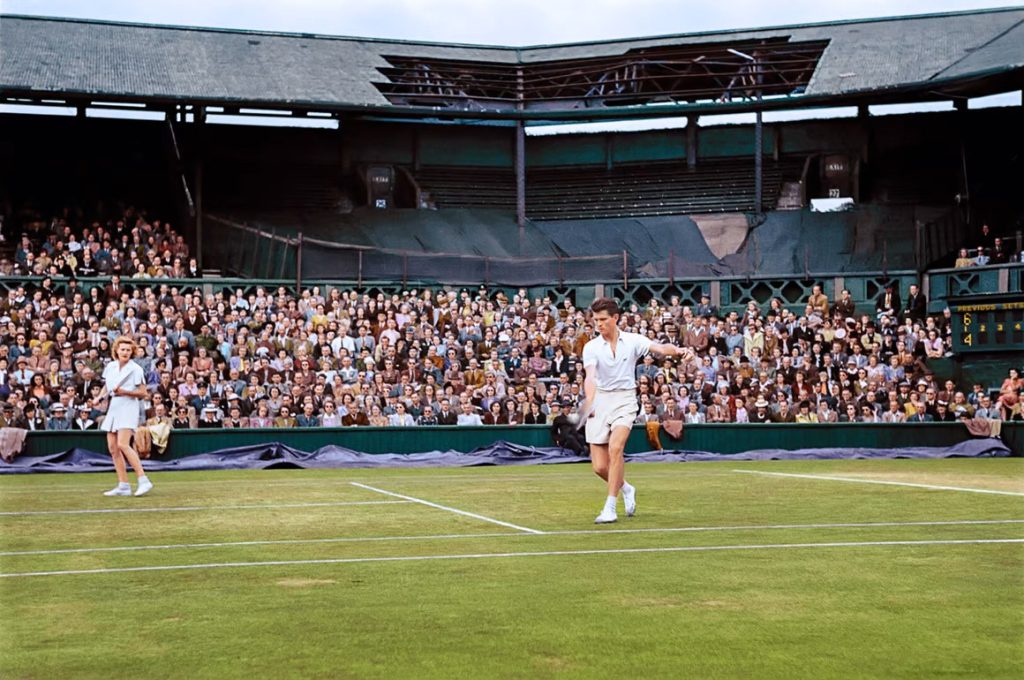
Colorization credit: Women’s Tennis Colorizations
Then again, she developed a bit of a reputation for hitting the dirt. At Wimbledon in 1946, she found herself suddenly horizontal. Upright again and newly grass-stained, she cracked, “And they say it takes three weeks to get laundry done in England.”
“She would never give up on a ball,” said Helen Dillon, a college teammate and occasional (unsuccessful) opponent. “She’d fall flat on her face to get to a shot. And she’d always get it.”
We can’t say exactly how much better Betz played on clay than other surfaces, because the existing records don’t indicate surface for some of the tournaments she entered. But the numbers we do have make the point well enough. She won 84% of known matches of grass and 83% on hard courts. In 159 outings on dirt, she won a whopping 92%.
* * *
By 1941, Pauline was already close to the level she’d sustain for the remainder of the war. She won eleven titles that season and reached her first Forest Hills final. According to my historical Elo ratings, she took over the number one ranking in August, though she lost it when Sarah Palfrey Cooke beat her for the US championship.
Palfrey Cooke stepped aside to have a child, and Betz proved herself superior to everyone else left in the field. In her short amateur career, she beat Brough 16 of 20 times, Osborne 18 of 26, and Doris Hart a whopping 19 of 21. Even Palfrey Cooke, who Pauline would call a “thorn in her side,” only defeated her five times in a dozen tries between 1941 and 1945.
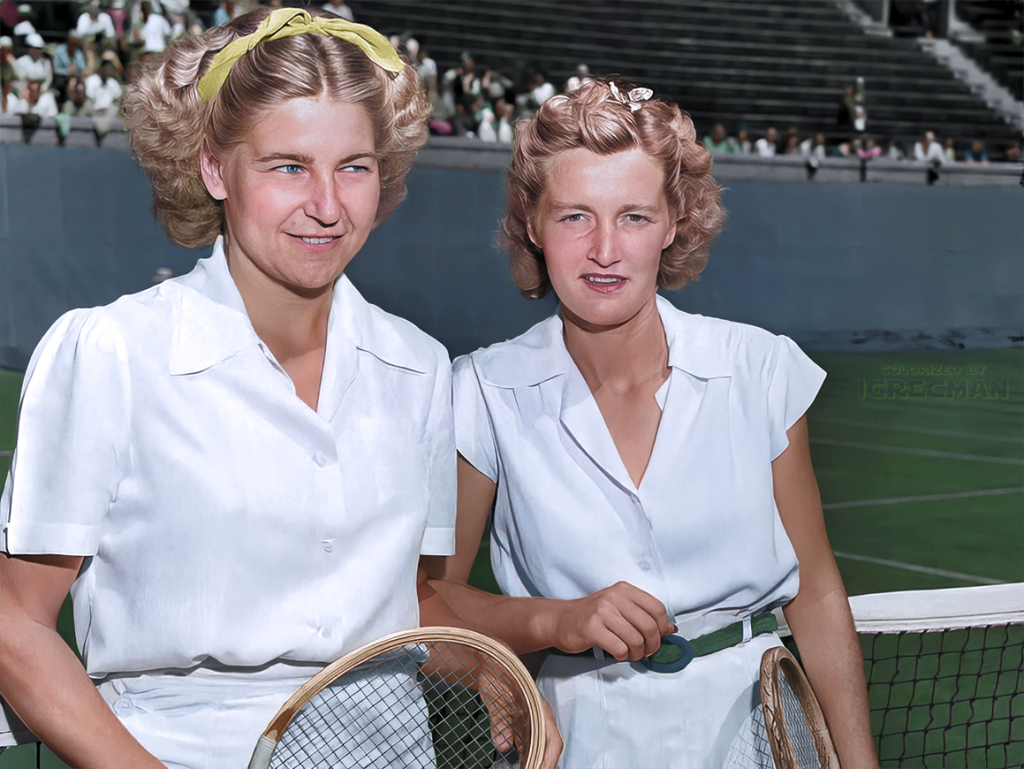
Colorization credit: Women’s Tennis Colorizations
Alas, one of those five upsets was another Forest Hills final, when Palfrey Cooke came back in 1945. Sarah didn’t have the big game of Brough or Hart, but she was the one woman on the circuit who could outsmart and out-steady Betz. Her anticipation was second to none, and her return of serve was even better.
Palfrey Cooke is indirectly responsible for Pauline’s expulsion from the amateur ranks. Sarah’s husband Elwood, a Wimbledon singles finalist in 1939, turned pro after the war. He wasn’t good enough to hold his own with the likes of Riggs, Budge, and Kramer, but he thought that he could find lucrative opportunities for the two strongest women in the amateur game–Sarah and Pauline.
Elwood wrote to clubs around the country to gauge interest in a Betz-Palfrey Cooke tour. One of those letters got back to USLTA headquarters, and you already know the rest of the story: Pauline was immediately suspended for “negotiating to turn professional.”
The judgment was particularly galling because the purported offense was something that men did all the time. Negotiations between promoters and top amateurs were only nominally secret. When Don Budge turned pro, the USLTA gave him a celebratory send-off. Kramer got the same treatment. Held to the same standards that the association applied to Betz, those men would have been banned from their final tournaments.
Palfrey Cooke didn’t care much about the suspension, since she had given up the amateur game. The stakes were higher for Pauline, so it was lucky that Elwood was indeed able to put together a financial success of a tour. The ladies booked twenty-plus dates around the United States and another dozen in Europe. Playing some nights for a fixed fee and others for a percentage of the gate, they finally converted their tennis prowess into a respectable income.
On court, though, there was little hope of turning the rivalry into a going concern. While Sarah’s smarts kept things interesting, it was clear that Betz was the superior player. She won 27 of 34 completed matches–another three were either tied or abandoned.
Meanwhile, Brough, Osborne, and Pat Todd took the titles at Forest Hills, Wimbledon, and Roland Garros, respectively. Depending on the source, Brough or Osborne was the number one player for the season. Betz was better than all of them.
* * *
By the late 1940s, men’s professional tennis was thriving. Budge and Riggs continued to draw crowds who remembered their pre-war exploits. Kramer won Wimbledon and Forest Hills in 1947, then signed a contract to take on Riggs to determine the true world number one. Two years later, Richard “Pancho” González joined the pro ranks and eventually became the man to beat for a decade.
Women’s professional tennis was much more touch-and-go. Back in the late 1920s, Suzanne Lenglen was the drawing card that launched the pro game. But the other great player of the era, Helen Wills, had no interest in playing for money. Helen Jacobs might have signed up, but financial success hinged on a compelling storyline. A great rivalry like Lenglen-Wills or Wills-Jacobs would’ve done the trick. No other plausible pairs came along.
Alice Marble turned pro and barnstormed through 61 stops with the British Wightman Cup player Mary Hardwick in 1941. She won 58 of them. Her celebrity was sufficient to draw crowds, but her pro matches would always be more like exhibitions than any real contest of skill. The Betz-Palfrey Cooke series wasn’t much better.
So after those few dozen dates in 1947, there weren’t any clear moves for Pauline Betz to make. She continued to play exhibitions with Sarah, and they added a “clinic”–a comedy show, really–to their act. A tour with Marble was mooted but never materialized. None of the remaining women on the amateur circuit were likely to draw crowds. Even if the players had been interested, Betz-Brough or Betz-Hart probably would have become just as predictable as Marble-Hardwick.
She got married, she wrote a book, and she played the occasional exhibition. That was pretty much the extent of her options.
* * *
Then came Gussie Moran.
Moran, another in the long line of strong players from Southern California, was four years younger than Betz. She had held her own with Brough as a junior but failed to develop into a superstar, in part because she didn’t care quite enough to make it happen. No one ever compared her to a stevedore.
Still, she beat Doris Hart and reached the semi-finals at Forest Hills in 1948. That was good enough to merit a trip to Wimbledon in 1949. She fell in the third round at the All-England Club, but you wouldn’t know it by her press cuttings. She debuted a pair of lace underwear that flashed every time she ran for a shot. Her eye-grabbing garment didn’t violate the letter of Wimbledon’s all-white rule, but it very, very emphatically flouted its spirit.
Suddenly, “Gorgeous Gussie” was the biggest name in women’s tennis. Her on-court results stagnated, in large part because she couldn’t handle the attention. Wherever she played, photographers would line up to capture just the right angle. The word “panties” appeared more often on American sports pages in 1949 than any year before or since.*
* I made up this stat. I stand by it anyway.
Fast-forward one year, and there was no obvious hook for a men’s pro tour. Bobby Riggs, defeated by Kramer, chose to step away from competition and become a promoter. González wasn’t yet at Kramer’s level, so a rematch of their 1949-50 duel wouldn’t draw the crowds. No man in the amateur game was ready to make the move.
The biggest name in tennis was Gussie. Riggs gave the lace-underwear queen a giant financial guarantee to headline the tour, then signed up Betz as her opponent. Kramer and the entertaining Pancho Segura would make up the other half of each night’s card.
The pro troupe in 1950. L to R: Betz, Kramer, Moran, Segura
The tour was a disaster. Moran remained ambivalent about the spotlight. She did well enough with the press, but she was no exhibitionist. The crowds came to see lace underwear, and she didn’t deliver. Pauline proved to be the flashy one, wearing silver lamé shorts that would’ve gotten her kicked out of Wimbledon, not to mention any respectable restaurant on the Eastern seaboard.
Worst of all, Gussie just wasn’t that good. Pitting the best player in the game against the sexiest one was a dreadful way to keep fans checking the sports pages for the updated won-loss record. Pauline won the first nine matches. Moran didn’t get as close as 6-4 until the fourth stop of the tour.
One-way traffic was terrible for the gate. Riggs and Kramer pleaded with Betz to take it easy. They might have made more money if Pauline got hurt and had to be replaced. She was barely fazed by the USLTA’s ham-handedness, but when urged to play less than her best, she broke down and cried.
This being Pauline Betz, she quickly put herself back together. “I wasn’t about to let them cancel the tour,” she told an interviewer in 2005. “So let’s just say Gussie Moran got better all of a sudden, and the tour continued. I studied economics in college.” Gussie ultimately won 14 of 74 decisions. Riggs lost money, but the ladies did okay.
* * *
After the Betz-Moran tour, no promoter would touch women’s professional tennis. Pauline went back to family life, and she had five children within a decade.
We’re left only with a few glimpses of what might have been. Maureen Connolly, winner of nine majors between 1951 and 1954, had the star power to draw crowds. Had she stayed healthy, she probably would’ve gone pro. Betz, 15 years her elder, was the only plausible opponent for a Connolly tour.
Later in the decade, the US Professional Championships–the biggest pay-for-play tournament on the calendar–added a women’s competition. Pauline entered whenever she could, and she was undefeated until 1960. In 1956, she won two matches against Doris Hart when Doris was the reigning Forest Hills champion. She lost to Althea Gibson in three sets in May 1960, then reversed the result at an exhibition three months later. Even at age 41, no one could definitively claim to be her superior.
Betz–now Pauline Betz Addie, married to sportswriter Bob Addie–settled into a quieter life of coaching. Even in her seventies, she held her own in a regular doubles game with college players. Donald Dell, a US Davis Cup captain and a one-time student of Pauline’s, called her “one of the sport’s forgotten jewels.”
Forgotten, alas, yes. Though I’d like to keep the emphasis on jewel.
Dell said, “I defy you to find anyone who didn’t like Pauline.” Stan Hart, an author who spent a year in the early 1980s tracking down former champions, wrote, “If you didn’t like Pauline Betz Addie, there had to be something wrong with you.”
She was a rare tennis great who managed to mix down-to-earth charm with unflappable confidence. She told Time back in 1946, “If I were a second-rater, I’d quit.” There was never any risk of that.
